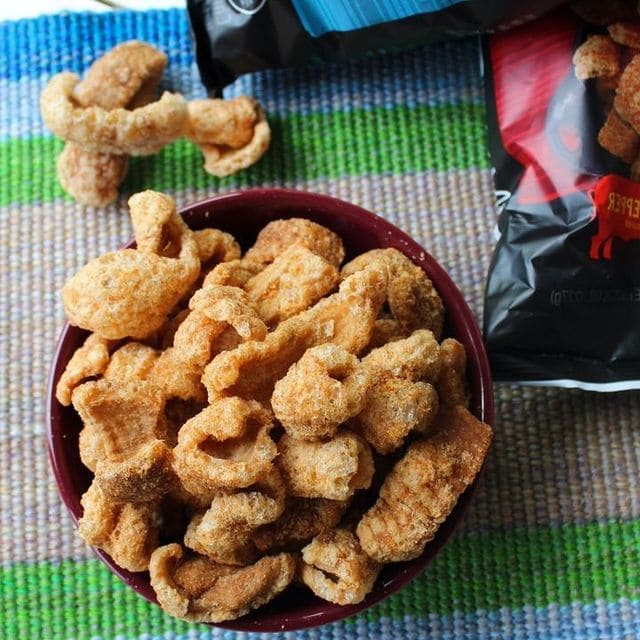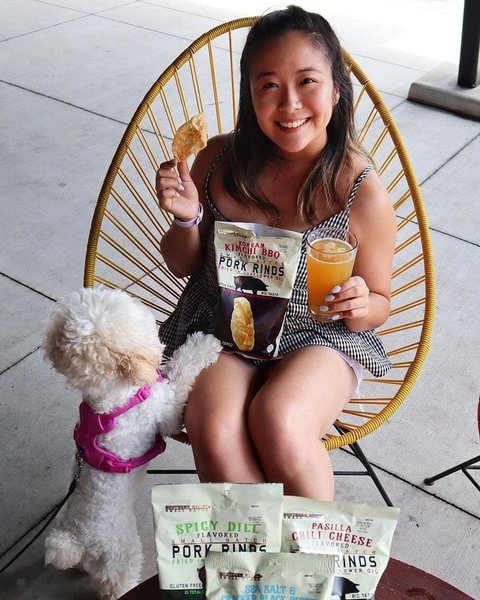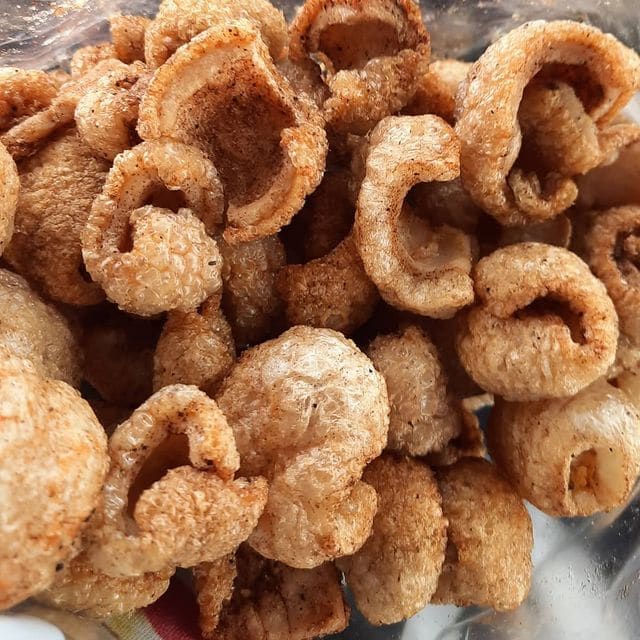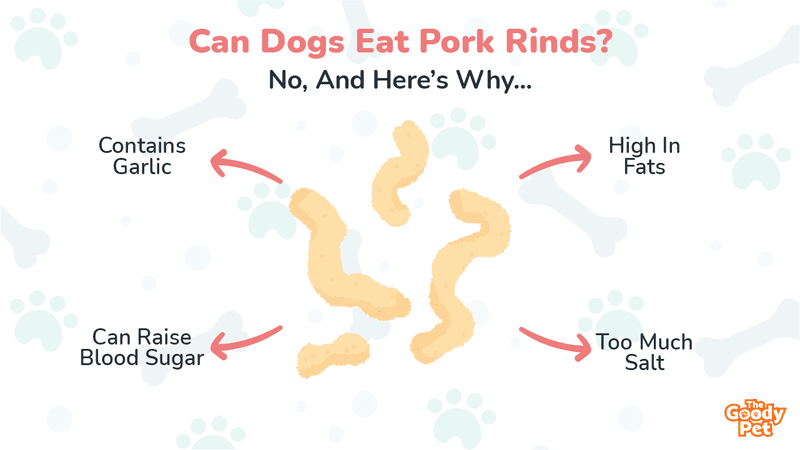Also known as Chicharrón in other cultures, there is no denying how fine a snack pork rinds make with their crunchy feel and savory taste. Like any other snack, the urge comes for you to share some with your dog as it wags its tail and fixes its gaze on you in expectation. But should you be sharing this very one with your Fido? Can dogs eat pork rinds?
No, pork rinds are not safe for consumption by dogs, so avoid feeding these Chicharrones to your canines. One of the reasons this snack is harmful to your dogs is that it has a massive collection of fat, which is dangerous to your dog.
Perhaps you are still wondering what could go wrong if your dog eats pork rinds? What must you do if your canine friend has been feeding on this snack? You’ll find the answer to these and even more as you read on.
What Happens If Dogs Eat Pork Rinds?

What happens to a dog if it eats pork rinds depends on the quantity it munches. A few may have no ill effect on your dog, but too much can lead to digestive problems like diarrhea and vomiting. Besides, your dog also risks having some allergic reactions.
While pork itself may be safe for your canine, pork rinds are unhealthy owing to the composition and method of preparation.
Chicharrones may contain seasonings like salt, chili, onions, garlic, vinegar, cinnamon sugar, and many more. These ingredients are toxic to canines, making them unsafe for canine consumption.
Are Dogs Allowed To Have Pork Rinds?
No, whether in small or large quantities, dogs are not allowed to have pork rinds.
If your pork rind contains an ingredient like garlic, there is no quantity of this allergen that is healthy for your dog. That’s why it is best you avoid feeding the snack to your dog under any circumstance.
Also, remember that despite the crispy and flaky feel of the snack, it is still a fatty food. You won’t see fat dripping out as characteristic of pork, but it is still fat nevertheless. Your dog’s digestive system isn’t structured to deal with most of the lipids present in the snack.
What Should I Do If My Dog Eats Pork Rinds?
If your dog has eaten only a few pork rinds, nothing may go wrong, but you must stop your dog from taking any more of it.
If your furry friend begins to show some allergic reactions, such as itching, vomiting, continuous licking of the feet, and gastrointestinal problems, then call your vet. They are in the best position to tell you if your canine would need some medical attention or if it’s nothing to worry about.
Will Pork Rinds Hurt A Dog?

Without mincing words, pork rinds can hurt dogs in several ways. So, if you’re considering feeding your Fido some pork rinds, here are three reasons why you should not.
Firstly, your dog risks suffering from sodium poisoning due to the high sodium content in most pork rinds preparation. According to data available in the public domain, 0.5 oz of plain pork rind contains 270 mg of sodium.
This quantity exceeds the 0.07% recommendation in dry foods for adult dogs. Salt is one of the seasonings to watch in your dog’s meal, and the concentration in pork rinds is not ideal for canines.
Again, the fried variety is especially fatty and can lead to inflammation of the pancreas. That causes this organ to release inflammatory cells and toxins, which could harm your furry friend’s intestines. When this happens, the result could be fatal. You’ll agree that it isn’t worth the risk of giving your dogs some pork rinds after all.
Another reason is the possibility of triggering high blood pressure in your canine. Pork rinds are high in high saturated fat and unhealthy kind of cholesterol. Feeding your dog pork rinds could lead to hyperlipidemia, a harbinger of high blood pressure. Studies also reveal that even a slight increase in cholesterol level is enough to bring about hypertension.
Do Pork Rinds Raise Blood Sugar?
Yes, pork rinds can raise blood sugar in dogs. Though directly, pork rinds wouldn’t be able to do so because it is free of sugar and glucose. However, they are high in fat and calories.
Several researchers concluded that excess fat might cause a reduction in insulin secretion, allowing sugar from other foods to amass without a check. If this continues, your canine risks developing diabetes due to high blood sugar.
In summary, though pork rinds are sugar-free, they can still indirectly raise your dog’s blood sugar, as long as its overall diet contains some sugar.
Are Pork Rinds Sugar-Free?
Yes, pork rinds are sugar-free. Nutritional data shows that pork rinds do not contain any sugar.
Also, the snack does not contain carbohydrates and little or no vitamins and minerals. It is grossly full of proteins and fat.
Do Pork Rinds Count As Protein?
Yes, pork rinds have high protein content, about 60% of the nutritional value. Nevertheless, they still do not make the perfect source of protein for canines.
Dogs require ten amino acids from their protein meal, and though pork rinds contain most of them, they are only present in low quantities. Hence, the proteins in pork rinds are termed incomplete.
Are Pork Rinds And Chicharrones The Same Thing?
No, pork rinds and chicharrones are slightly different even though they share a similar process. Pork rinds are exclusively from the skin, while chicharrones include some fat and meat with the skin and are cut from the belly.
Notwithstanding, the inclusion of some meat in chicharrones doesn’t make it any better than pork rind in feeding your dogs. Both pork rinds and chicharrones contain the same nasty ingredients which your furry friend should not take.
Again, the naming points to the different cultural backgrounds. The name “pork rinds” is used in the United States to refer to fried or roasted pig and, “chicharron” is South American in origin.
What Is The Difference Between Pork Rinds And Pork Skins?
Pork rinds and skin differ based on processing.
Pork skin refers to the flesh of a pig without any form of preparation, in essence, raw form. Pork rinds are an American word for pork skin processed by first boiling, then drying, and lastly, deep frying.
Pork skin is raw and needs to be cooked before consumption, while pork rinds are ready for eating right from the package. Also, You’ll find pork rinds to be flaky and crunchy while pork skin is soft.
Lastly, the processing of pork rinds ensures that it contains less fat than the pork skin, which is raw and unprocessed.
With all said, pigskin is even unhealthier for your dog due to the presence of unprocessed fat and the potential presence of the parasitic roundworm called Trichinella spiralis.

Do Pork Rinds Have Hair?
Pork rinds shouldn’t have hair. However, while there’ll be attempts to remove hair from the pork skin before processing, the hair does not often come off entirely. Hence, it isn’t unusual to still find pork rinds with hair on some of them.
Pork rinds having hair is a valid reason to be concerned, knowing that canines don’t digest furs. On accumulation, it can lead to intestinal blockage. So, dogs eating pork rinds need to be careful of the quantity of animal fur they would also be swallowing.
Why Do Pork Rinds Have No Carbs?
Pork rinds have no carb because meat generally has none. Unlike plants that produce and store carbohydrates using photosynthesis, animals only have carbohydrates in their body as glycogen.
This glycogen remains only as long as they are alive. At death, the glycogen in the meat begins to break down rapidly due to a lack of respiration. At the same time, part of it merges with glycerol molecules to become fat.
Though there are arguments that dogs do not need carbohydrates, this is untrue as vets include carbohydrates as the list of the six important nutrients that must be in your canine’s food. So, this no-carb diet doesn’t make a perfect munchy for your dog.





